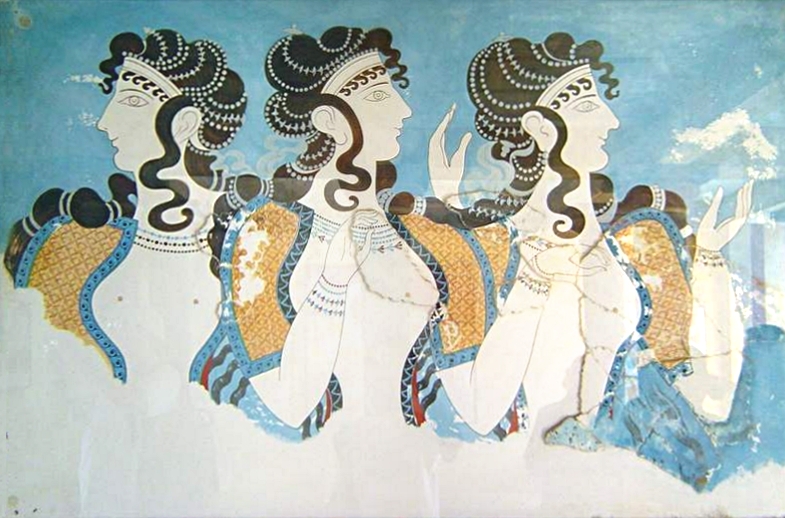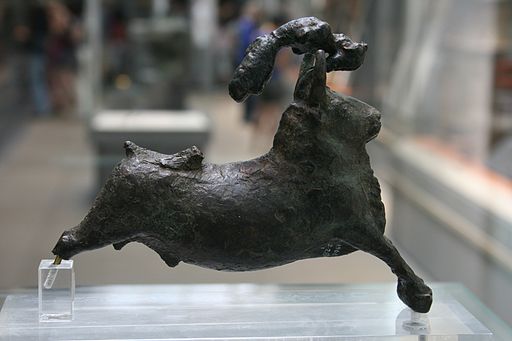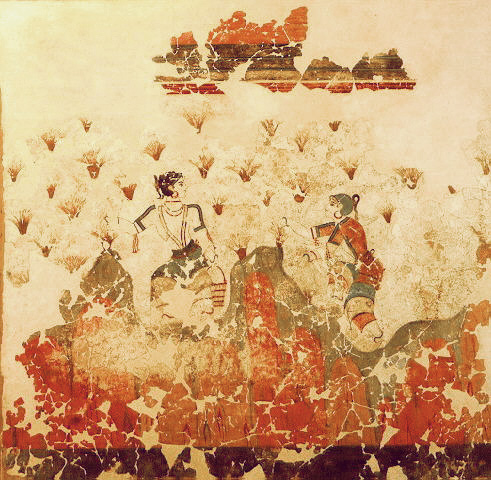In 2005, two entomologists discovered 65 new species of slime-mold beetles (genus Agathidium). They named three of the species in honor of President George W. Bush, Vice President Dick Cheney, and then-Secretary of Defense Donald Rumsfeld (A. bushi, A. cheneyi and A. rumsfeldi).
Minoans Just Wanted to Have Fun
I love the Minoans. I love their art, their fashions, their celebration of color, and their obvious joie-de-vivre, or whatever they would have called it. I thought it appropriate to blog about them during this time of year when the weather turns dreary, and when many of us are making resolutions about living more joyfully, and resolving to live a bit healthier.
Named after their legendary King Minos, this sophisticated Bronze-Age civilization emerged on the island of Crete at just about the same time as the ancient Egyptians. The Minoans had impressive plumbing, which I discuss in my Poop book, sophisticated writing, and pretty wild fashions. They seem to have been a peaceful lot–their castles are unfortified and there are no scenes of war in their artwork. They loved colorful clothing and glittery ornamentation. In their artwork they dance, and enjoy bountiful feasts; they play lyres, flutes and trumpets. Scantily-clad athletes, both men and women, jump over bulls, just for fun.
Both men and women wore their hair curled and coiled with falling ringlets to the shoulders. The men’s skirts—all right, we’ll call them tunics—stopped at the knee or, as above, might be hiked daringly higher. Everyone’s clothing was tightly belted at the middle– women (and possibly men as well) may have worn stiff corsets.
The Minoans appeared to have prized fit bodies and narrow waists. Both men and women wore wide, tight belts with rolled edges. Some historians have suggested that these metal belts were riveted to the waist in a person’s youth and were worn for the rest of their lives—incentive to lay off those honey-soaked dates.
The fun seems to have stopped about 1500 BC, when a tidal wave struck the island. After that, the inhabitants of the nearby Greek city-state, Mycaenae, took control. The humorless, belligerent Mycaenaens were considerably less fun than the people over whom they ruled. (Four hundred years later, the Greek epic poet Homer would write about the Mycaenaen siege of Troy in his Iliad.)
La Donna was Mobile
According to some accounts, in 1814, Luigia Verdi grabbed her baby and hid in the tower of the town’s church. Soldiers killed everyone in the church except for them. Her baby, Giuseppe, grew up to compose operas.
source: Kathleen Krull, Lives of the Musicians, p 37
It Won’t Go Viral
Mosquitoes cannot transmit HIV from one person to another. Any virus particles that might get sucked up by a mosquito are destroyed by the insect’s digestive system.
Don’t Let the Bed Bugs Bite
A friend of mine just emailed me for suggestions about Pricelining a hotel room in New York City, something I do pretty often. I shared my strategies with her, and then offered her unsolicited advice about checking for bed bugs. As you no doubt know, bed bugs are a big problem in a great many cities (not just New York). They’re appearing not only in hotel rooms, but also in department stores and movie theaters, and they are extremely resistant to the most common class of insecticides.
I have met quite a few entomologists, but even the most die-hard of us bug lovers draw the line at sharing our beds with Cimex lectularius. Although bed bugs don’t transmit disease, they can inflict pretty awful psychic trauma.
So, here are some simple strategies that can help you avoid contact with these loathsome little arthropods. Mind you, this advice is for the traveller. If you live in a home with an infestation, you have a whole different set of issues that are beyond the scope of today’s blog. (My good friend, E., who lives in Brooklyn, had a bad infestation in her building where the bugs were resistant to repeated sprayings. She eventually had to move.)
First, don’t be too concerned about movie theaters and taxicabs. Bedbugs don’t travel on people the way, say, lice might. But they can migrate into your luggage.
The first thing I do when I know where I’m staying is to look up my hotel on bedbugregistry.com. If you find that an incident was reported, don’t panic. It may well have been dealt with, but calling the hotel to inquire won’t help. I mean, think about it. It’s a public relations disaster for a hotel to acknowledge that it has bedbugs, so of course they’re going to tell you the problem has been resolved.
Here’s what I do, whether the hotel has been reported or not. When I arrive at my room, I put my suitcase in the bathroom. Then I do a thorough check for bugs, underneath the mattress cover, in the seams of the mattress ticking (look for poppy-seed-sized black flecks, which is their poop), and along the baseboards and behind the bed. I bring a small flashlight, magnifying glass, and a Ziploc baggie. (It’s important to be able to produce anything you might find for the people at the hotel so you can change rooms if necessary—that’s why the baggie.)
I admit that even if I don’t find any evidence of bugs, if the hotel was listed on bedbugregistry.com, I leave my stuff in the bathroom. If you’re truly paranoid, you can use a lint roller on your luggage before you bring it back into the house–and then throw it all into the dryer at the hottest setting.
No Sweat
On the International Space Station, NASA’s water recovery system can recycle about 93 percent of astronauts’ sweat and urine back into drinking water that “meets or exceeds most municipal water product standards.”
Source:
NASA at http://tinyurl.com/6leglp
Heeling Power
King Louis XIV was only about 5’4” tall. Not coincidentally, men’s fashions featured high heels and high wigs during his reign.
Smack!
Women who regularly wear lipstick inadvertently ingest about four pounds of lipstick during their lifetime. In 2009, the FDA found lead in nearly all samples of lipstick that it tested.
Carnation Instant
 It’s a quaint tradition, watching your older sister, or your older brother’s date, (or your own teenager), try not to mortally wound her prom date as she fastens on a boutonnière.
It’s a quaint tradition, watching your older sister, or your older brother’s date, (or your own teenager), try not to mortally wound her prom date as she fastens on a boutonnière.
The flower in the buttonhole tradition began in 18thcentury France when French noblemen began sticking flowers in the buttonholes of their waistcoats. The flowers served a very real purpose back then, as the wearer could remove the flower and hold it under his nose when passing through smelly corridors or streets.
Good Gravy
In the Middle Ages, thick slices of bread, called trenchers, were used instead of plates. After the meal, the gravy-soaked bread was distributed to the poor.






